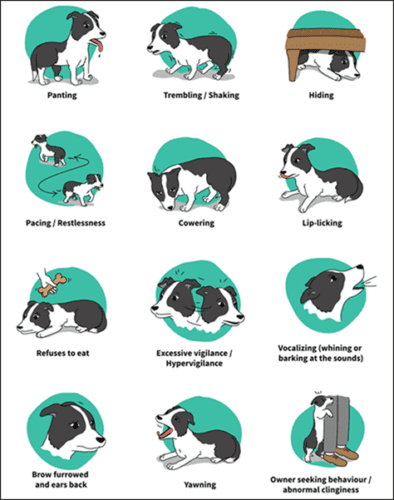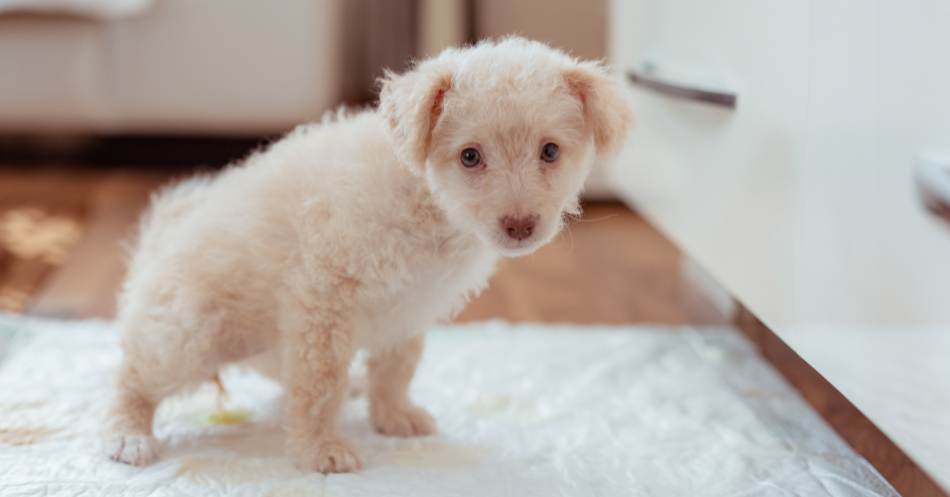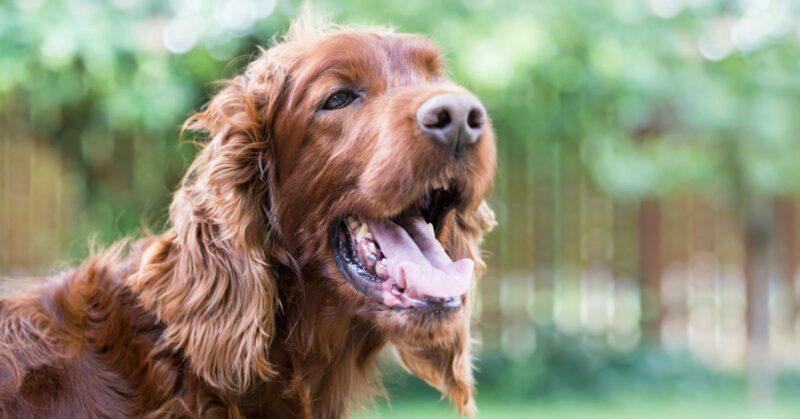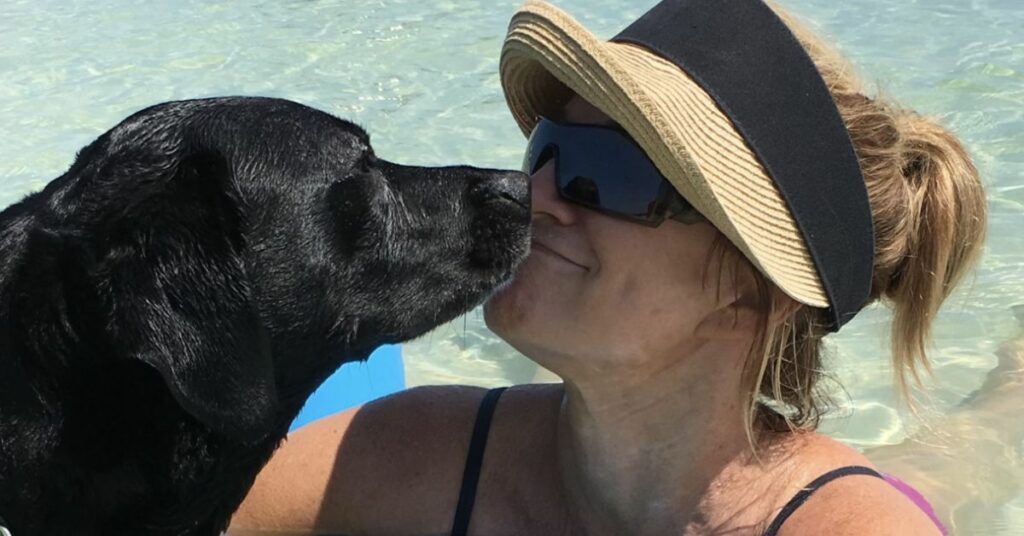
How to Manage Your Dog’s Noise Aversion During the Holidays
Noise aversion is a real and serious health issue for as many as 67% of dogs.1 Having had two dogs, Chilly and Buck, who suffered from this condition, I know first hand what it can do to a dog and his parents. I also know how important it is for his parents to be educated about it if they are going to help.
Many of my previous posts on noise aversion have focused mostly on common summertime noises, like thunder and 4th of July fireworks. However, noise aversion isn’t a seasonal condition. Depending on your dog’s specific fear, it could strike at any time — even during the holidays.
It’s the Most Wonderful Time of the Year – Or is it?
All kinds of noises that we humans are accustomed to can cause fear, and even panic, in dogs with noise aversion. Especially during the holiday season, sounds that are fun and festive to us could be downright terrifying to dogs with noise aversion. Sounds don’t necessarily have to be loud to cause symptoms of anxiety. A few holiday noises that have the potential to trigger symptoms of anxiety in dogs with noise aversion include:
- Sudden laughter — If you plan on having a gathering or two at your home during the holidays, this is something to think about. Do you have a friend or relative whose laugh startles you every time you hear it? It could be even more unsettling to your dog if he’s prone to noise aversion.
- Music — Whether you plan on playing or singing music at a volume that’s louder than normal, or if you’re anticipating carolers, what is music to your ears might not be for your dog.
- Boisterous conversation — When you’re dealing with a crowd of happy people, even regular conversation (with some occasional whooping and hollering) can potentially reach a noise level that could trigger symptoms of anxiety.
- Doorbells and bells – Doorbells and sounds of greeting guest can be triggers for some dogs. The noise of jingly sleigh bells is unfamiliar at the very least. But they could actually cause a fearful reaction for some dogs.
- Fireworks or parades — Some neighborhoods celebrate the New Year with a colorful (and loud) display of fireworks. It’s no surprise that this could be bad news for dogs with noise aversion. Or maybe there’s a festive holiday parade complete with sirens and marching band drums. If your home is near the parade route your dog will get an earful.
Pin Me!

Could Your Dog Have Noise Aversion?
Unfortunately, many dog parents don’t talk to their veterinarian about noise aversion. They may not recognize the symptoms, or they may not realize that noise aversion is a medical condition.
It’s important to realize that even mild symptoms of noise aversion are worth discussing with your veterinarian. Noise aversion does not go away on its own, you can’t soothe it away, and it usually becomes worse over time. According to Dr. Sharon L. Campbell, a veterinary internist for Zoetis, a dog with untreated noise aversion may begin to show more severe signs, react to more noises, or take longer to recover after each noise event. Dogs can also develop other forms of anxiety, such as separation anxiety.
That’s what happened to my dog, Buck. He developed separation anxiety a few years after he developed noise aversion. It got to the point where my husband and I even took separate vacations in order to avoid subjecting him to being left alone!
If you notice any of the following symptoms in your dog, have a conversation with your veterinarian about whether it could be noise aversion.
- Aggression
- Cowering
- Destructiveness
- Excessive vocalization
- Freezing or immobilization
- Furrowed brow or laid-back ears
- Hiding
- Hypervigilance
- Inappropriate elimination
- Refusing to eat
- Self-harm
- Yawning

Some of these signs are a lot more obvious than others. If you’re not sure if your dog has noise aversion, try taking this quiz. You can print out the results and bring them to your veterinarian when you talk to him about your dog’s symptoms.
Surviving the Holidays With Noise Aversion
It’s heartbreaking to see a dog who is fearful, especially during what is arguably the most festive, happy time of the year. Most dogs will jump or react to any sudden or loud noise. But a dog with noise aversion goes beyond that. These dogs are truly feeling terrified, and this fear can be a serious quality of life issue. The good news is that, even with the holidays right around the corner, there’s still time to get help.
Your veterinarian is likely to recommend one, or a combination of, the following approaches to treatment:
- Environmental management includes masking the noise, providing your dog with a safe haven to escape to, or encouraging him to go to a more soundproof location. It could also include pheromones or wearables, like a wrap or earplugs.
- Behavior modification may take the form of systematic desensitization or counter conditioning, where you train your dog to associate the noise with a positive experience, or a combination of both. Your veterinarian may refer you to a veterinary behaviorist for help with either of these approaches.
- Pharmacological treatments can be used on their own or in combination with another treatment.
A Simple Treatment for Noise Aversion
There are a number of pharmacological options out there, but not all have been FDA approved to treat noise aversion, and not all have proven to be effective. Another downside is that many medications can leave dogs feeling sedated or dopey, so while they’re not experiencing panic, they’re not really enjoying the holidays with their families either.
A couple of years ago, we began using SILEO® (dexmedetomidine oromucosal gel) for Chilly during noise events that he finds stressful. It’s been a complete game changer!
SILEO is the first FDA approved medication to treat canine noise aversion. It works on its own without any other treatments or behavior training, so it’s hard to imagine a more simple approach to treating fears caused by noise.
Another thing I love about SILEO is how easy it is to administer. It comes in a syringe that’s preloaded with gel. Your veterinarian will determine the correct dosage for your dog. All you have to do is set the dosing ring on the syringe to the correct spot and lock it in place. Then place the syringe between your dog’s cheek and gums and it will be absorbed by the mucous membranes in his mouth, so you don’t have to worry that he’ll spit it out. And you don’t have to go through the trouble of disguising it as a treat to trick him into swallowing it.
We try to give Chilly a dose of SILEO 30 to 60 minutes before we expect any noise to begin. That way, by the time it starts he’s totally chill. But even if a noise event sneaks up on us, we give it to him as soon as we can, and he calms down pretty quickly. SILEO doesn’t cause him to fall asleep, and he doesn’t get groggy, so we can still enjoy our time together. SILEO is safe to re-administer every 2 hours, up to 5 times during the course of a noise event. If we have to give Chilly a second dose, we wait until he starts showing signs of noise aversion, before giving it. That way we know if he needs another dose or not.
Taking the Stress out of Holiday Noise
One of the nice things about holiday-related noises is that they’re fairly predictable. Most parades and displays of fireworks are scheduled and advertised, and most parties and family gatherings are planned well in advance. So you’ll have plenty of time to prepare and manage any symptoms of noise aversion that your dog may experience as a result of the noises.
If your dog has shown any signs of noise aversion, talk to your veterinarian about whether treatment with SILEO could work for you. He doesn’t have to experience symptoms of fear or anxiety as a result of the noisy holidays. With the right treatment, he can stay calm and enjoy the holidays with the whole family!
This is a sponsored post. However, all opinions and anecdotes are my own, and I never promote any products or brands I don’t believe in. ~Petfully yours, Kristen
IMPORTANT SAFETY INFORMATION: Do not use SILEO® in dogs with severe cardiovascular disease, respiratory, liver or kidney diseases, or in conditions of shock, severe debilitation, or stress due to extreme heat, cold or fatigue or in dogs hypersensitive to dexmedetomidine or to any of the excipients. SILEO should not be administered in the presence of preexisting hypotension, hypoxia, or bradycardia. Do not use in dogs sedated from previous dosing. SILEO has not been evaluated in dogs younger than 16 weeks of age or in dogs with dental or gingival disease that could have an effect on the absorption of SILEO. SILEO has not been evaluated for use in breeding, pregnant, or lactating dogs or for aversion behaviors to thunderstorms. Transient pale mucous membranes at the site of application may occur with SILEO use. Other uncommon adverse reactions included emesis, drowsiness or sedation. Handlers should avoid direct exposure of SILEO to their skin, eyes or mouth. Failure to lock the ring-stop on the syringe before dosing SILEO could potentially lead to an accidental overdose. Always review INSTRUCTIONS FOR USE before dispensing and dosing. See full Prescribing Information.
Sileo® is a trademark owned by Orion Corporation Orion Pharma Animal Health. It is manufactured by Orion Corporation and distributed by Zoetis under license from Orion Corporation Orion Pharma Animal Health.
Kristen Levine has a consulting relationship with Zoetis.
1According to the Harris Poll: Custom Motion Sickness and Noise Aversion Omnibus Pet Owner Quantitative Research Report, December 2018.
XXX-XXX







Comments (0)